Timing is Everything, Damnoen Saduak Floating Market

|
• Best Western Barkly Motor Lodge Hotel • Best Western Lake Inn • Best Western Bell Tower Inn • Ballina Island Motor Inn |
Feature Photograph

In my blog entry last week I talked a bit about having patience when pursuing someone to pose. This is without a doubt the most patience and longest time period I’ve ever pursued a subject. Three years! Why this person? Perhaps it’s more due to her personality than her appealing looks, maybe her lifestyle, religion, or maybe it’s something else I don’t even realize. Regardless, I enjoyed the shoot tremendously and capturing her in the traditional Islamic dress was a real treat. This image is significant because of the perseverance necessary to achieve my goal. The picture itself, the techniques, the image quality, is rather routine. The personal reward is extraordinary.
Lets talk a bit about the technique and if there is enough interest I’ll make a detailed learning topic in the next week or so. These were captured outdoors at the right time of day using a single off-camera strobe. The possibilities using a single light are many. You can create flat lighting, hard lighting, directed lighting, or just about anything you desire. All settings on the camera and strobe were manually set and you’d be surprised how easy it is to do so. Below is a shot from the same session, but a totally different style of light and resulting look.

Weekly Photo Outing
I’ve been holding off doing an outing to the Damnoen Saduak Floating Market because like Angkor Vat there is just so much to show and talk about. The floating market is a place I take clients at least 1-2 times a month, we’ve seen the specials on the Discovery and National Geographic channels, and we’re all very familiar with common scenes. How can I possibly show you anything different? I’m not sure I can. I can process the pictures in a unique way, look for unique expressions, and possibly things you didn’t notice the first 4-5 times you visited.. but the truth is the images will all have the same flavor. Instead, I’ll share a few compilations of subjects I’ve enjoyed.
The images below were shot with cameras ranging from an inexpensive point and shoot to the top professional DSLR. Can you tell from the image quality alone? Not at the small resolutions sized for web display! You can certainly tell as the images are used for larger prints or display, but any one of these images can be used to make a perfectly fine 8×10. For the most part its not the camera, instead it’s the person using the camera. So how can you tell which camera was used for which shot? In some you won’t be able to tell, others you will. Look for perspective and depth of field and apply the knowledge you’ve gained in previous topics and you’ll be able to pick out which came from a compact digital, and which came from a DSLR with a 70-200 zoom, and which came from a DSLR with a wide angle zoom, and possibly even some shots with prime lenses. Have fun!

The above shot is a very common scene. A sampan looming in the foreground large as life, and two seemingly smaller sampans in the background. The sampans are identical in color and size.
Your boat guide will almost always stop at the main gift store where a old traditional furnace cooks up sugar cane and you can watch them process the product into Thai treats. They’ll even give you free samples. Tasty!
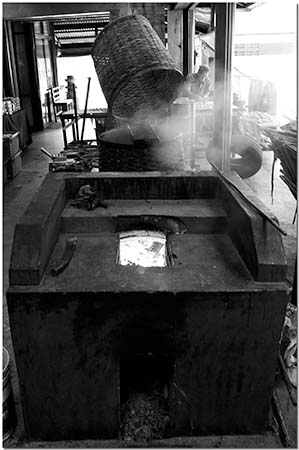
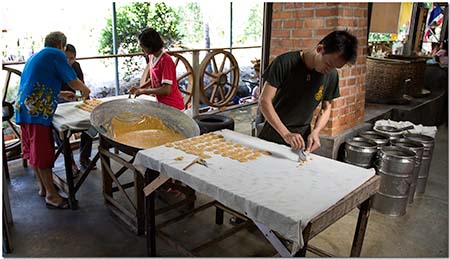
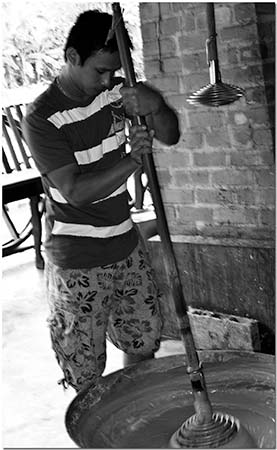
The dwellings along the klong are timeless. Color is ok, but decent B&W processing can almost make you believe the images were taken 50 years ago. Compare color to B&W and keep the differences in mind when processing your own images.
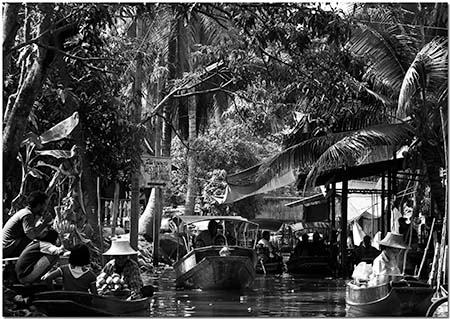
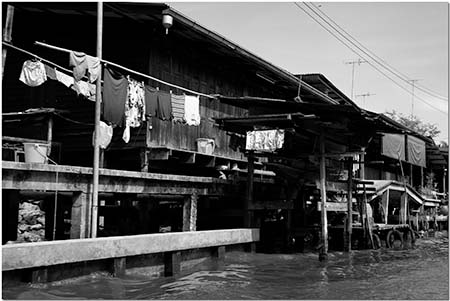
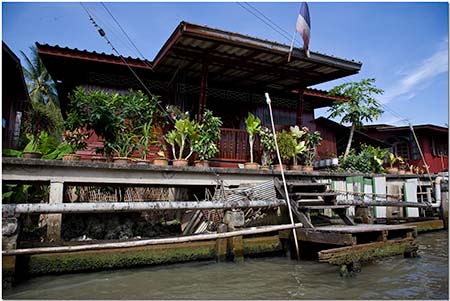
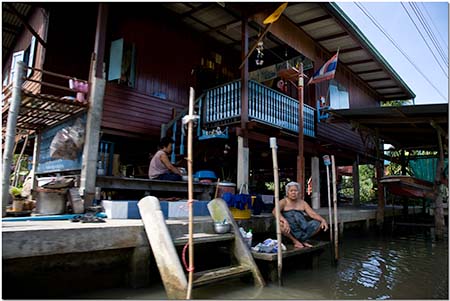
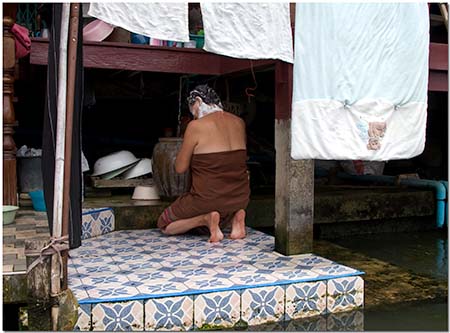
Below is a common shot of the traffic.
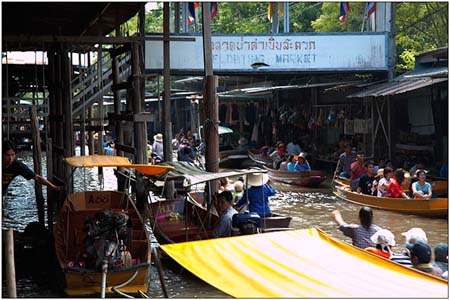
As you cruise the klongs of the market you might notice some signs to the snake shot. A friend decided to stop and see what the snakes were all about. In one of the below images he looked almost excited to be holding the snake.. ;o)
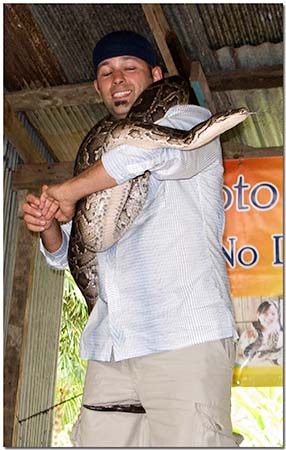
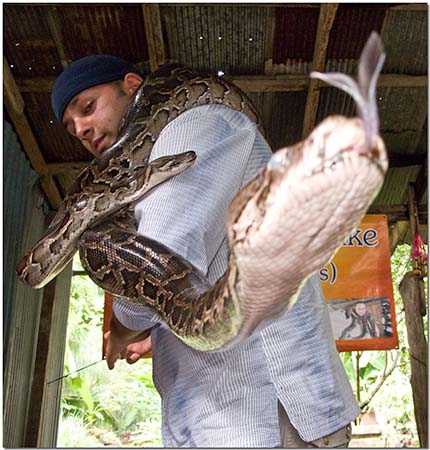
No collection of floating market images would be complete without a study of the characters piloting the boats, in many cases floating shop keepers.
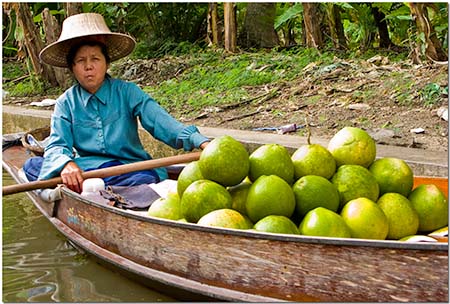
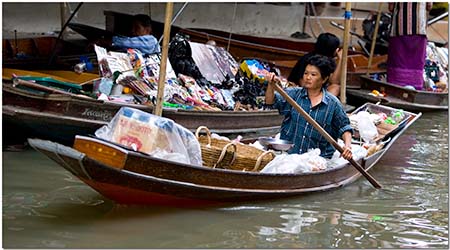
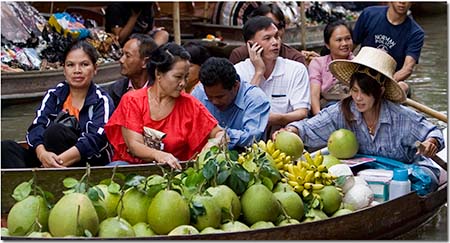
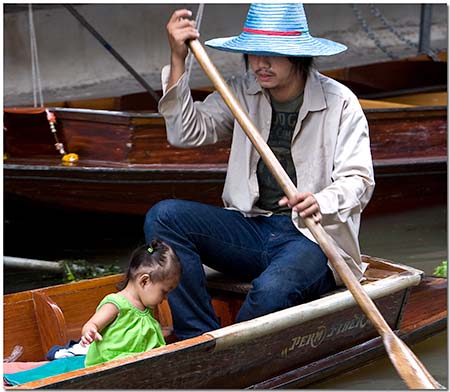
Everywhere you look there are things for sale, trinkets, art, food, and unfortunately most of it you see over and over again. Below are a few shots of the common items you’ll see for sale and the people doing the selling.
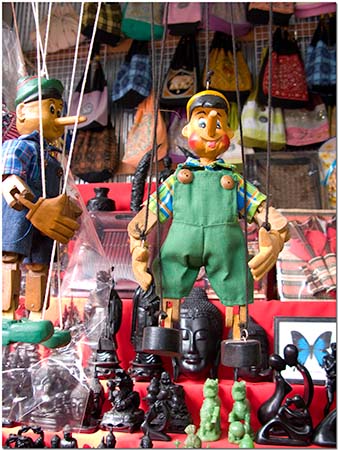
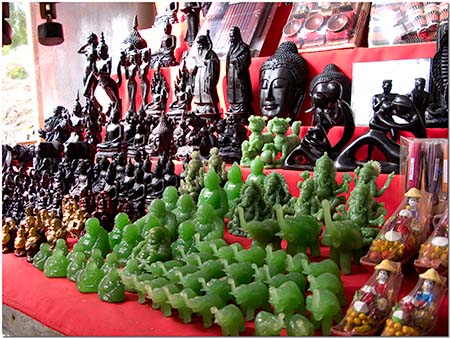
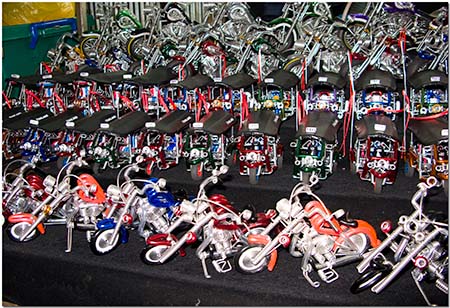
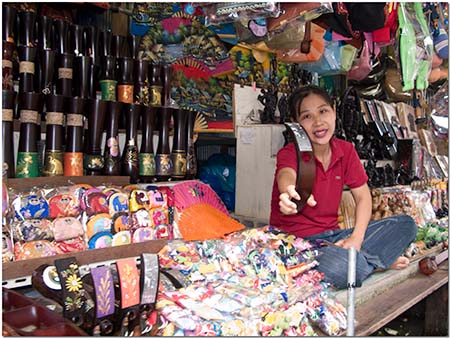
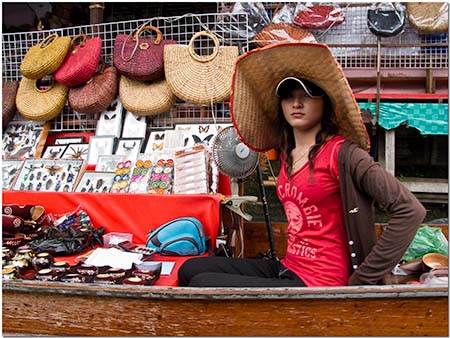
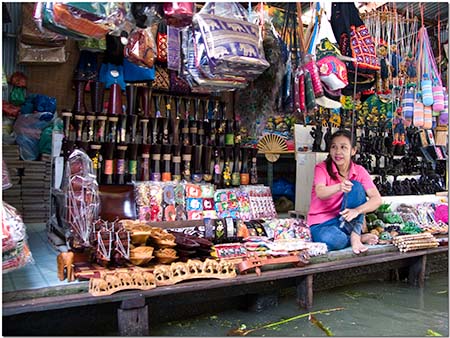
A sight that personally interests me are the boat docks, lifts, and repair areas. Below is a frequent sight of a boat lift.
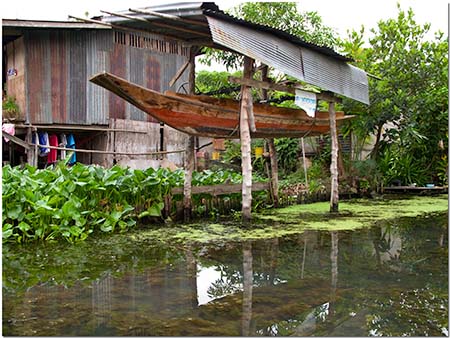
There are many more areas to share and in future columns I’ll make sure to include a few more outings to the floating market. However, you’re not done once you leave the market. The areas surrounding the market are rich in culture and photographic opportunities. Below are a few from a coconut plantation not even a kilometer from the market. A coconut plantation is a topic by itself, but here’s a taste.
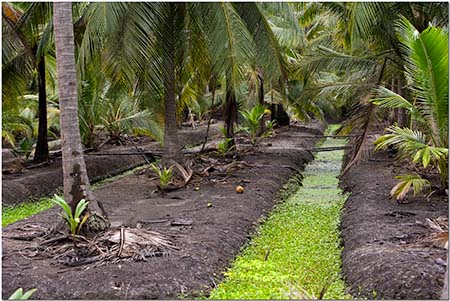
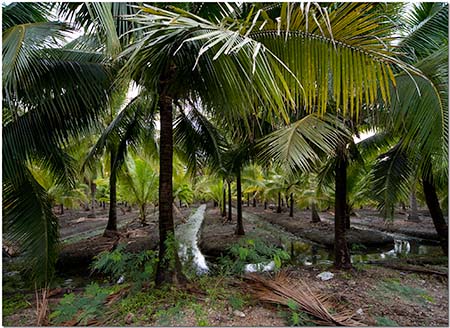
Timing is Everything
Last weeks feature photograph briefly discussed the art of timing. Many people have asked me how I capture certain expressions, events, or moments in time. I’m accused of being able to see the future! It’s nothing like that. The simple truth is its 95% technique, and 5% predicting what will happen by studying the subject.
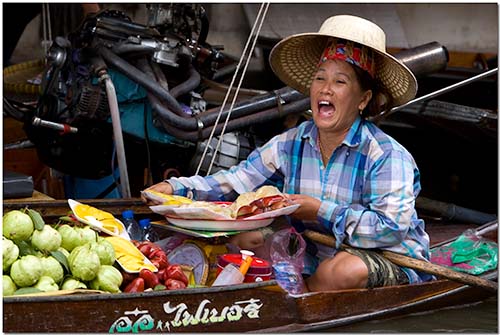
The above picture shows an excited vender at the floating market with her mouth wide open in laughter. Much more interesting of a photograph then if she was showing less emotion or animation. How did I capture this exact moment?
The answer is surprisingly simple. I sat there observing her for about ten minutes and observed her personal habits. This wouldn’t be unlike watching a dog catch a Frisbee, you observe, you learn the sequence of events likely to take place, and then you use a tried and tested technique to effect the capture. In this case I watched her serve about 15 customers. With a few of them I noticed if the customer was friendly and animated she’d also become friendly and animated.
I set the camera to continuous shooting at 4.5 fps, framed her with my 70-200/2.8 IS zoom, braced and focused, and waited. When a customer approached her and I noticed her face start responding I held down the shutter button and shot approximately 8 frames in 2 seconds. In those 2 seconds her face completely changed from all business, to a huge open mouth smile, and back again. All you do is go through the frames and select the most pleasing image. That’s all there is too it. You can use this technique for people, sports, news events, weddings, or just about and all there is too it. Learn your subject, set up the shot, and wait for the moment. Below are the 8 frames in sequence, you can see how easy it was for me to select the shot above.
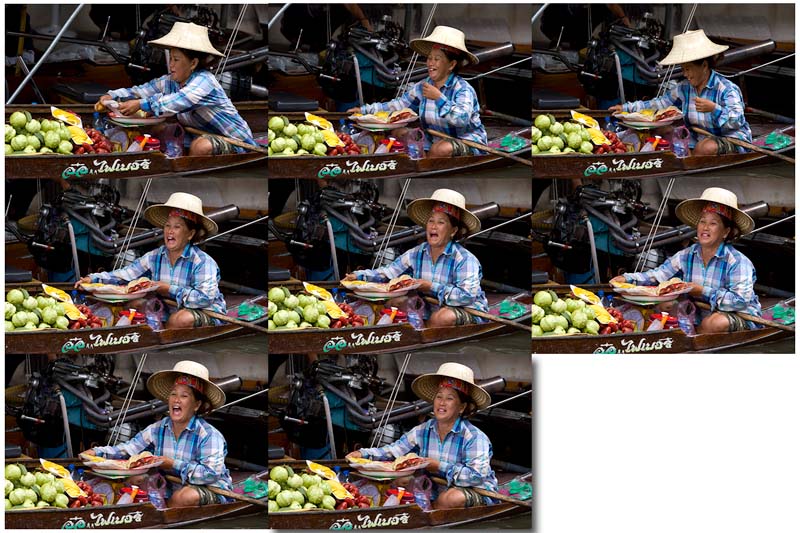
Photography News of Interest
Nikon does it again! Nikon continues to roll out some very nice professional tools and after Canon dominating the uber-resolution professional DSLR market for the last 8-9 years Nikon fires back with an (on paper) class leading flagship D3x. I say on paper because the Canon 1ds//1ds2/1ds3 models are proven professional tools used industry wide, and we’ve yet to see a single review or even sample image from the D3x. Still, many are anticipating Nikon’s usual great performance. Competition is always a good thing, it sparks innovation and drives down the prices for consumers. Read Nikon’s D3x press release here.
The all-in-one consumer zoom lens for DSLRs are gaining a significant share of the market. And they should, these lenses are very useful and much better quality than in years past. The Nikkor 18-200 and Canon 18-200 (38-320mm 35mm equiv.) APC sensor lenses have sold very well and now Tamron releases their own version. Read the review here.
Is video really the future of photography? This week the Canon 5d Mark II shipped to it’s US and Europe customers and was the first camera to offer 1080p HDTV video and people sure are excited about it. Imagine being able to use all your still camera lenses on a video camera and you’ll get the picture. Read about how Adobe is working on future video technology beyond their already market leading offerings. Here.
The UK continues to lead the western world on laws concerning photographers and terror. Many are upset with the laws. If you live in the UK you’ll want to read this article here.
Readers Submissions
Steve,
One of my fondest memories from my childhood is sitting with Dad out at Rongotai on the southern tip of New Zealand's north island as planes flew in over the gusty Cook Strait, struggling to remain level as they descended for landing at the airport of New Zealand's capital city, Wellington.

My folks long since made the move north to the warmer climate of Auckland and on my last trip back to Kiwiland in 2007, Dad and I went out to Auckland airport where I took a few shots of planes coming in to land at New Zealand's busiest airport, Auckland International. Unlike major airports around the world, you can get very close to the flight path at Auckland International which allows for great photo opportunities.

The tarmac of New Zealand's airports used to be dominated by Air New Zealand and NAC, a smaller domestic airline which I believe was eaten up by Air New Zealand some 30 years ago. You'd also see a few Qantas jets as well as the American airlines, Pan Am, Continental and United.

I don't know if any American airlines fly into New Zealand these days. The major Kiwi airports of Auckland, Wellington and Christchurch are dominated by Air New Zealand, of course, Qantas, and then the Asian carriers. Thai has a daily flight between Auckland and Bangkok – although that will soon disappear – and then you also see the other major Asian airlines such as Singapore Airlines, Air Malaysia and Cathay Pacific.

As much as I like watching planes landing, I have never actually enjoyed flying. As someone with a short attention span, I find it dreadfully boring and I need to take a long a variety of things to keep myself busy. Laptop, novel, guide book and a bunch of magazines as well as a Walkman (yep, I haven't gone modern with an IPod or an MP3 player yet) and I still find myself bored. I can't imagine how many guys fly all the way from the US to Thailand, in some cases 30 odd hours in a plane and at airports. The longest flight I have ever endured was Singapore to London, a flight which almost killed me. And that was only 13 odd hours!
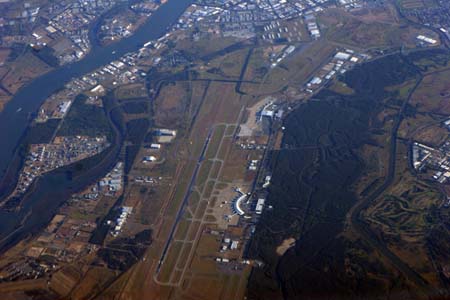
The one thing I do like about flying is gazing out the window at what is down below, imagining what it is like to live there and how the lifestyle of the people below differs from mine.
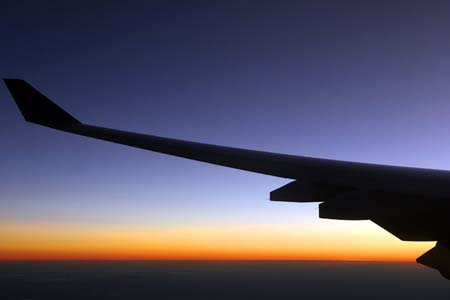
I also love taking photos as the sun is rising or going down as the jet screams towards is destination at close to 1,000 km/h.
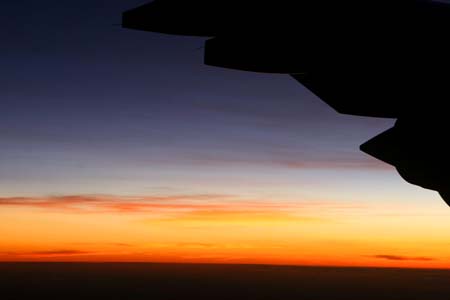
All of the photos of jets on the ground were taken at Auckland airport which ordinarily does not have anything like the number of flights per day as Bangkok's Suwannaphum but I bet Auckland International is much busier than Suwannaphum at the moment!
Stick
Stick –
Great submission! Love the pictures of the jets and fun narrative..
I wonder how many of us look down below at the changing topography and dream about unknown civilizations? Maybe all of us.
Thank you!
Steve
I suspect the readers submissions will be a highly anticipated section of this column and I encourage anyone with photographs and travel accounts they d like to share to please send them to me at: QandA@Bkkimages.com
Readers Questions
Hi Steve,
I'm looking for a new point-and-shoot camera and getting overwhelmed by variety of new models. I'd normally look at the design, number of pixels, and the size of the camera. Sony Cyber-shot T-Series are very much to my taste but I'm not sure about picture quality. I heard that the smaller the lens is, the more distorted pictures would be.
I am pretty clueless about technical stuff but I'm sure there should be something else I should be looking for in a camera (without sacrificing the design..I'm just a woman!) Advice in a nutshell would be appreciated.
Best,
Jodi
Jodi –
This is an excellent question. There are hundred of ‘like’ models out there and consumers are confused on which one is the best buy for their purposes. I’m afraid I’m not going to be of much help.. ;o)
The vast majority of compact point and shoot digitals have image sensors which are very close to the same size and produce very close to the same image quality. So what else is there?
Features. Shop for features vs. price in a major brand and you probably won’t go wrong. Features such as the size of the LCD, physical size and weight, if the camera takes memory card types you already own so you don’t need to buy them again, battery type and how many images you can take per charge, lens zoom range and speed, weather/water seals, included software, file type output (jpegs, raw), and what camera controls are available via dials and knobs vs. being forced to use the LCD and navigation controls (very slow). Shop only for the features you know you’ll find use and find value in, and ignore the rest.
You mentioned “megapixels.” Megapixels should be the very last thing you’re concerned with in a modern digital camera. Read Ken Rockwell’s excellent article titled “The Megapixel Myth” and prepare to learn about one of the biggest marketing hypes in modern technology.
You also mentioned the size of the lens. It would be too easy to say “size matters” but that’s only partly true. Physically the faster lenses (wider aperture) which work better in low light must be larger. The best quality DSLR lenses are certainly larger, anyone seeing me holding my big white 300/2.8 IS telephoto in my hands knows it must produce some great images to be worth it’s heft and girth. But when it comes to compact point and shoot lenses size matters very little. Its more how you use the lens than how big it is. Instead of size look for the maximum aperture and zoom range. Also look for the design of the lens. You mentioned Sony and they often use the legendary Zeiss optical designs which are very good.
99% of compact digital point and shoot users use their cameras in fully automatic mode. If you’re in that 1% who desires to get creative, use external flash, prefer raw files for their technical advantages, or want the best in low light performance.. then look carefully at the models the pros use for personal use such as the Canon G10, Panasonic LX3, and Nikon P6000. You might find the premium features and control match the premium price.
I hope this helps.
Steve
Please submit your questions to QandA@Bkkimages.com All questions will be answered and most will show up in the weekly column.
A Snapshot of Bangkok Images Week in Review
With the airports shut down and protests being the big news there hasn’t been any new business this week. There should have been, but if your customers can’t fly in..
Infocus Blog
Getting caught with your pants down!
I was a boy scout so I should have known better. Last week I took my car in for some body damage repairs forgetting that I left my tripod in the back.
This last Monday we were treated to a spectacular sky show with Venus, Jupiter, and the moon appearing in a unique alignment making them visible together, the moon being a small crescent shape laying almost on its back with Venus and Jupiter laying on top. Both were very bright in the sky over Bangkok which is usually covered with enough smog and haze to obscure even the sun.
Without a tripod I was only able to achieve the same blurry images they put on the front page of the Bangkok Post. Didn’t anyone shooting for the Post own a tripod, or did they also leave theirs in the car?
Not to fear, from now until mid-February this trio will be appearing at different times, different parts of the sky, and different intensities with different slices of the moon showing. We have plenty of time to capture some exceptional shots. Tonight I’m sitting here wondering what famous foregrounds (temples, buildings, structures, etc) I want in the image, and what moon phase will be the most dramatic.
Anyone interested in how to use your compact digital or DSLR to the most advantage to capture the show?



